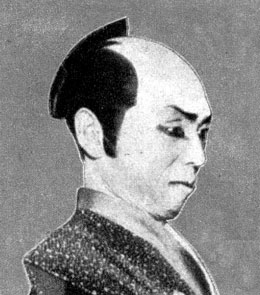| ICHIKAWA HAKOTORA |
| THREE GENERATIONS | |||||
| Ichikawa Hakotora I Ichikawa Hakotora I |
|||||
|
|
|||||
| Ichikawa Hakotora II Ichikawa Hakotora II |
|||||
|
Born the 19th day of the 10th lunar month of 1867. Disciple of Ichikawa Sumiz˘ V, he held the names of Ichikawa Tomiroku, Ichikawa Suzuhachi and Ichikawa Sukeroku. He became disciple of Ichikawa Danjűr˘ IX in 1888 and received the name of Ichikawa Hakotora II in May 1888. He settled in ďsaka in 1895 and became a disciple of Nakamura Ganjir˘ I. He quickly became an important supporting actor in Ganjir˘ I's troupe and was said to be for his master what Nakamura Kichinoj˘ I was for Nakamura Kichiemon I: an indispensable stage presence for the star! One Kabuki connoisseur once said that Ganjir˘ I's troupe without Hakotora was like coffee without sugar. His best roles were Tabei in "Kawash˘", Janome no Ganpachi in "Okazaki", Bannai in "Kanadehon Chűshingura" or Shibata Sadanoshin in "Wankyű Sue no Matsuyama". He had also a strong and positive influence on the artistic development of his master's heir Nakamura Kanjaku IV. He died the 24th April of 1944.
|
|||||
 |
|||||
|
Ichikawa Hakotora II playing the role of Sakurada Rinzaemon in the drama "Igagoe D˘chű Sugoroku", which was staged in November 1925 at the Nakaza |
|||||
| Ichikawa Hakotora III Ichikawa Hakotora III |
|||||
|
Born the 8th of July 1930. He started learning Kabuki at Nihon University in T˘ky˘. He made his debut on stage in April 1956, in ďsaka at the Nakaza, performing under the name of ďtani Sanzabur˘ in "Onatsu Seijűr˘". He became a disciple of Nakamura Ganjir˘ II and received the name of Nakamura Rogan II in July 1970. He finally took the name of Ichikawa Hakotora III in November 1977, playing the roles of Hara G˘emon and Takemori Kitahachi in the classic "Kanadehon Chűshingura". He performed in ˘shibai for the last time in January 1988 at the Nakaza, where he played the roles of Hara G˘emon, Takemori Kitahachi and the hunter Kakubei in the classic "Kanadehon Chűshingura" and the role of Gen'ichi in "Uekiya". He quitted the Sh˘chiku and spent his latter years as a Kabuki instructor for kodomo shibai or inaka shibai. He died the 11th of February 2010. He had never been a big name in the Kabuki world, and yet I believe that Hakotora would become a bridge between the tradition and the future of Kabuki. Hakotora was born in Chiba Prefecture as a farmerĺs son. After he graduated from evening classes at a senior high school, he went to Nihon University in T˘ky˘, to major in theater. At the university, he belonged to the Kabuki Club for four years. One of his clubmates was the late Arashi Tokusabur˘, who was a good Kabuki actor well known for playing the leading parts in Media and other plays for director Ninagawa Yukio. After four years at the university, Hakotora entered Sh˘chiku, a production company to which all Kabuki actors belonged. "Sh˘chiku wanted only Tokusabur˘, for he was a star in the university Kabuki world", Hakotora said. "But the university forced Sh˘chiku to employ other Kabuki students all together. I was neither a good or enthusiastic student". In general, every Kabuki actor who comes from the outside world becomes a private disciple of a master, who is a hereditary Kabuki actor. Hakotora became a disciple of the late Nakamura Ganjir˘ II. "I was very stubborn, so that no one wanted me but my master Ganjir˘", Hakotora said. Ganjir˘ was a Japanese Living Treasure, and was known for reviving the obsolete Kabuki dramas, featuring manners and customs in Kamigata (in the Ky˘to and ďsaka areas). "My master was really a great actor", Hakotora said. "On the stage, he looked huge, though he was only five feet and a few inches high. When he died in 1983, I decided to quit Sh˘chiku. I knew I could never find anyone like my master Ganjir˘". Since then, Hakotora has devoted himself to promote Kabuki to those who are not familiar with it, especially school children. Many Japanese have misconceptions about Kabuki Ś that Kabuki is oldfashioned, difficult to understand, and snobbish Ś without going to a theater. "Kabuki is an entertainment for common people like you and me", Hakotora said. "Just having fun and diversion is all right. I want everybody to enjoy Kabuki either by watching it or acting". Hakotora spends most of his time teaching Kabuki, preparing for the performance, and making costumes and properties. He works during the night from 1-6 a.m. for a food catering company, and sleeps only four hours a day. His money, of course, is all spent on Kabuki, though he has not been to the theater for years. Hakotora holds training sessions and gives lectures for both adults and school children without tuition, and visits the old peopleĺs homes with his amateur Kabuki company. The stage for his activity is not limited to the Kansai area. He goes anywhere if asked, even outside of Japan. In summer 2001, he visited three cities in China and Mongolia with some of his pupils, all elementary school children, to perform Kabuki. His dream is to travel to New York with his young pupils and perform Kabuki. (extracted from an article written by Matsuda Mitsue in 2001, International Crossroads Fall 2001 from page 41)
|
|||||
|
|
| Contact | Main | Top | Updates | Actors | Plays | Playwrights | Programs | Links | FAQ | Glossary | Chronology | Illustrations | Prints | Characters | Derivatives | Theaters | Coming soon | News |